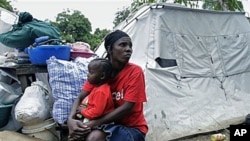More than 42 million people around the world were displaced by sudden natural disasters in 2010. That’s according to a new study from the Internal Displacement Monitoring Center of the Norwegian Refugee Council.
The Geneva-based center has been monitoring conflict and internal displacement since 1998. In 2008, it joined the U.N. in trying to determine a global estimate of people displaced by sudden onset natural disasters.
“The study we just released today is a follow-up to that...looking at global estimates of people displaced…in the world in 2009 and 2010,” said Kate Halff, head of the center.
She added, “If we look at the findings, we found that in 2010 over 42 million people had been estimated displaced as a result of sudden onset disasters, of which 90 percent, or corresponding to 38 million, have been displaced by climate-related disasters.”
Topping the list of climate-related sudden onset disasters are floods and storms.
Are things getting worse?
The center has only been looking at disaster induced displacement for three years.
“We’re in no position to comment first-hand on the increase in disasters over decades. What we do know is that other organizations or institutions are reporting that the number climate-related disasters has increased significantly over the last 20 years,” she said.
Mega-disasters
There are disasters and then there are mega-disasters. The term depends on the number of people displaced.
“We’re defining a mega-disaster as a disaster which is estimated to have displaced over a million people,” Halff said. “The biggest mega-disaster that we came across was the Sichuan earthquake in 2008, which displaced over 15 million people.”
Nearly 70,000 people were killed.
Worst hit areas
“Throughout the three years, over three-quarters of the people displaced globally were displaced in Asia. And when we look at the number of large-scale or mega-disasters the majority of these over this period was in Asia,” she said.
Other continents, such as Africa, are affected, too. “But,” she said, “the reality is that because of the scope of disasters and because of the number of disasters and…the high level of population in Asia, we have found that over these three years Asia has been consistently the most affected continent.”
Severe drought, such as the one in Somalia and neighboring countries, is considered a disaster. However, it falls into a different category. “It’s considered to be a slow onset disaster. We have really focused on sudden onset disasters,” Halff said.
Using the data
“The first purpose of the information is really to highlight the scale and the scope, as well as the complexity of the issue that we’re dealing with. So, really to create awareness and contribute to mobilizing decision makers into action…in terms of practices, but also in terms of policy,” she said.
A second objective is to gather information over time to analyze trends and patterns of disaster induced displacement.
“It’s very much a means toward better understanding disaster-displacement.” She said.
In 2009, 17 million people were displaced by sudden onset disasters and 36 million in 2008.









